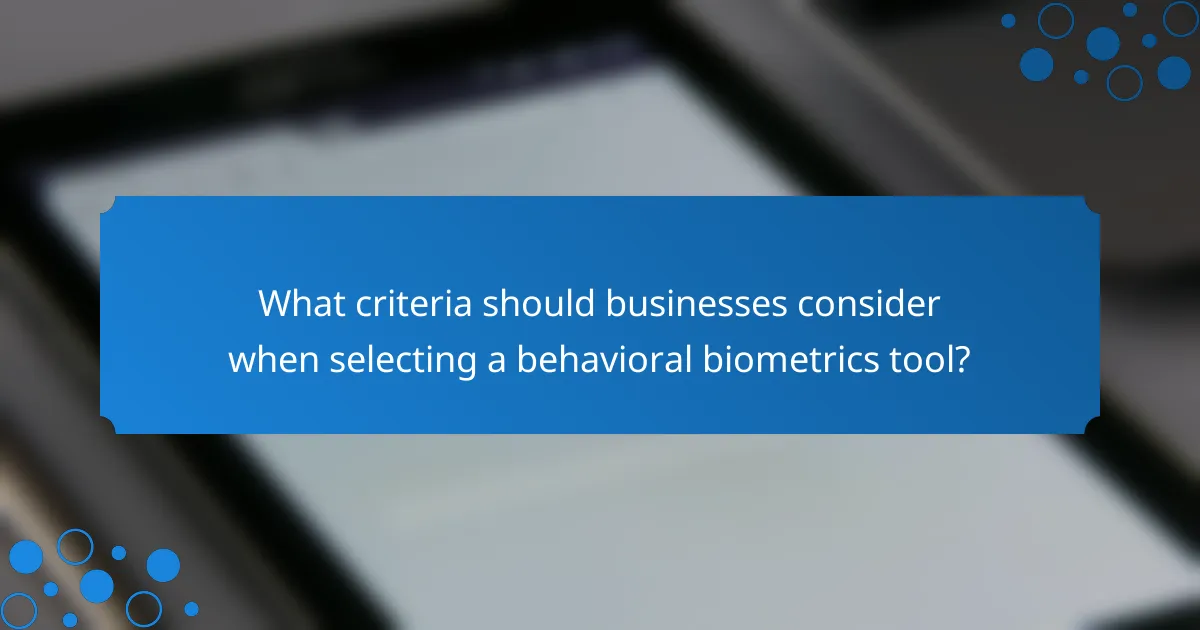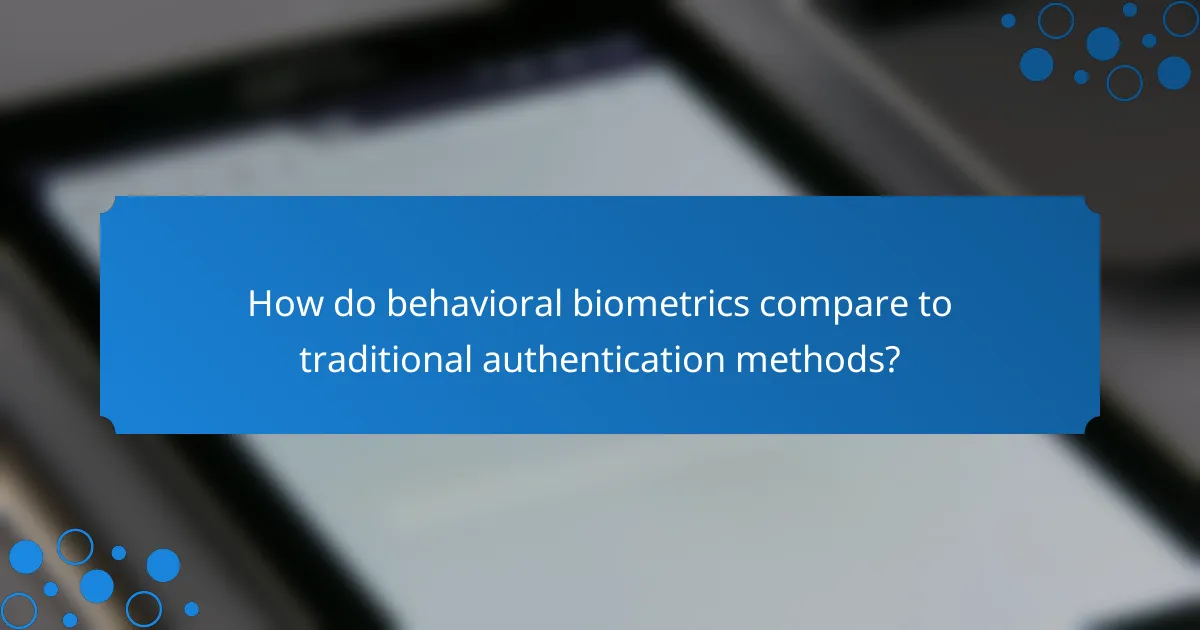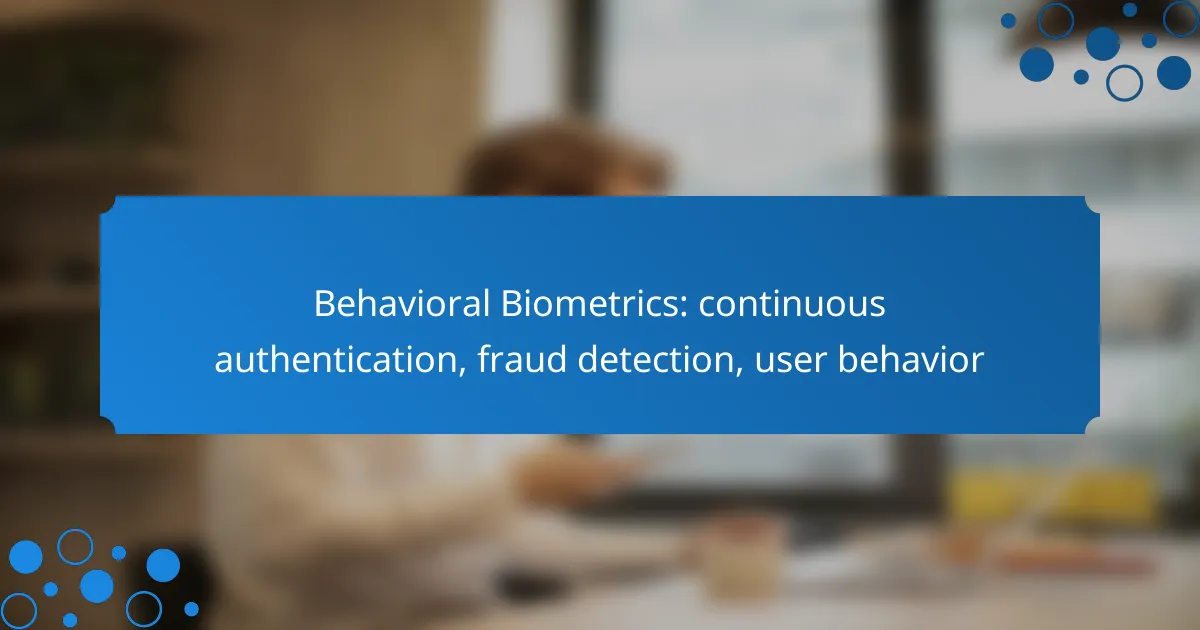Behavioral biometrics is a cutting-edge technology that enhances continuous authentication by analyzing unique patterns in user behavior, such as typing speed and mouse movements. By continuously monitoring these actions, it effectively reduces fraud and improves security, making it challenging for unauthorized users to gain access. This approach not only strengthens security measures but also minimizes disruptions for legitimate users, ensuring a seamless experience.

How does behavioral biometrics enhance continuous authentication in Canada?
Behavioral biometrics enhances continuous authentication in Canada by analyzing unique patterns in user behavior to verify identity in real-time. This technology helps organizations reduce fraud and improve security by continuously monitoring user actions, making it difficult for unauthorized users to gain access.
Real-time user monitoring
Real-time user monitoring involves tracking various behavioral metrics such as typing speed, mouse movements, and navigation patterns. By establishing a baseline of normal behavior, any significant deviations can trigger alerts or additional authentication steps. This continuous observation allows organizations to detect potential fraud as it occurs, rather than after the fact.
For example, if a user typically logs in from a specific location and suddenly attempts access from a different region, the system can flag this anomaly for further verification. This proactive approach helps mitigate risks associated with identity theft and account takeover.
Adaptive risk assessment
Adaptive risk assessment uses machine learning algorithms to evaluate the risk level associated with a user’s actions. By continuously analyzing behavioral data, the system can adjust its security measures based on the perceived threat. High-risk actions may prompt additional authentication, while low-risk behavior allows for seamless access.
This dynamic assessment is particularly beneficial in environments where user behavior can vary significantly, such as in financial services or e-commerce. Organizations can fine-tune their security protocols to balance user experience with protection, ensuring that legitimate users face minimal friction while maintaining robust security.
Integration with existing security systems
Integrating behavioral biometrics with existing security systems enhances overall protection without requiring a complete overhaul of current infrastructure. Many solutions can work alongside traditional authentication methods, such as passwords or two-factor authentication, providing an additional layer of security.
For instance, if a user fails to authenticate through a password but exhibits familiar behavioral patterns, the system can allow access after further verification. This compatibility ensures that organizations can adopt advanced security measures while leveraging their current investments in technology.

What are the key benefits of behavioral biometrics for fraud detection?
Behavioral biometrics offers significant advantages for fraud detection by continuously analyzing user behavior patterns to identify anomalies. This technology enhances security measures while minimizing disruptions for legitimate users.
Reduction in false positives
Behavioral biometrics significantly reduces false positives by relying on unique user behavior rather than static credentials. Traditional authentication methods often flag legitimate users as threats due to minor discrepancies, but behavioral analysis can differentiate between genuine and fraudulent activity more accurately.
For example, if a user typically types at a certain speed and rhythm, any deviation from this pattern can trigger a security alert. This precision helps ensure that only genuine anomalies are flagged, reducing unnecessary account lockouts and user frustration.
Improved detection of anomalous behavior
This technology excels in identifying anomalous behavior by continuously monitoring user interactions. It can detect unusual patterns, such as a sudden change in typing speed or mouse movement, which may indicate unauthorized access.
By establishing a baseline of normal behavior, behavioral biometrics can quickly highlight deviations that might go unnoticed by traditional security measures. This proactive approach allows organizations to respond swiftly to potential fraud, enhancing overall security posture.
Enhanced user experience
Behavioral biometrics contributes to an improved user experience by allowing seamless authentication without the need for frequent password entries. Users can access their accounts more conveniently, as the system continuously verifies their identity in the background.
This frictionless experience is particularly beneficial in environments where security is paramount, such as banking and e-commerce. Users appreciate the balance between security and convenience, leading to higher satisfaction and retention rates.

Which tools provide behavioral biometrics solutions?
Several tools offer behavioral biometrics solutions that enhance continuous authentication and fraud detection by analyzing user behavior patterns. These tools utilize machine learning algorithms to assess various metrics, such as typing speed and mouse movements, to verify user identity in real-time.
BioCatch
BioCatch is a leading provider of behavioral biometrics solutions, focusing on fraud detection and user authentication. It analyzes over 2,000 behavioral parameters, including mouse movements and scrolling patterns, to create a unique user profile that helps identify anomalies.
This tool is particularly effective in financial services, where it helps prevent account takeover and fraudulent transactions. By integrating seamlessly with existing systems, BioCatch provides real-time insights that enhance security without compromising user experience.
BehavioSec
BehavioSec specializes in continuous authentication through behavioral biometrics, offering a solution that monitors user behavior throughout a session. It employs machine learning to adapt to individual user patterns, ensuring that authentication remains dynamic and responsive.
With its ability to detect deviations from established behavior, BehavioSec can trigger additional security measures when necessary. This is especially useful in sectors like e-commerce and banking, where maintaining secure transactions is critical.
SecuredTouch
SecuredTouch provides a comprehensive behavioral biometrics platform that focuses on user experience while enhancing security. Its technology analyzes various factors, such as device orientation and touch pressure, to build a detailed user profile for authentication purposes.
This tool is designed to minimize friction for legitimate users while effectively identifying potential fraudsters. SecuredTouch is particularly beneficial for mobile applications, where user interactions can be monitored in real-time to prevent unauthorized access.

What criteria should businesses consider when selecting a behavioral biometrics tool?
Businesses should prioritize scalability, accuracy, and compliance when selecting a behavioral biometrics tool. These factors ensure that the solution can adapt to growth, maintain high performance, and meet regulatory requirements specific to their operational region.
Scalability and integration capabilities
Scalability is crucial for businesses anticipating growth or fluctuating user volumes. A behavioral biometrics tool should seamlessly integrate with existing systems, such as identity management and fraud detection platforms, to enhance overall security without disrupting operations.
When evaluating integration capabilities, consider whether the tool supports APIs and can work with various data sources. This flexibility allows for smoother implementation and better data utilization, which is essential for effective continuous authentication.
Accuracy and reliability metrics
Accuracy and reliability are vital for minimizing false positives and negatives in user authentication. Look for tools that provide clear metrics on their performance, such as detection rates and response times, which should ideally be in the low tens of milliseconds for optimal user experience.
Consider solutions that offer ongoing learning capabilities, allowing the system to adapt to evolving user behaviors over time. This adaptability can significantly enhance the tool’s reliability and effectiveness in fraud detection.
Compliance with Canadian regulations
In Canada, businesses must ensure that their behavioral biometrics tools comply with privacy regulations such as the Personal Information Protection and Electronic Documents Act (PIPEDA). This legislation mandates that organizations protect personal data and obtain consent for its use.
When selecting a tool, verify that it includes features for data encryption, user consent management, and audit trails. These elements not only help in compliance but also build trust with users regarding their data security and privacy.

How do behavioral biometrics compare to traditional authentication methods?
Behavioral biometrics offer a dynamic approach to authentication, contrasting with traditional methods like passwords and PINs. While traditional methods rely on static credentials, behavioral biometrics continuously assess user behavior patterns for ongoing verification.
Continuous vs. static authentication
Continuous authentication monitors user behavior in real-time, allowing for seamless verification without interrupting the user experience. In contrast, static authentication requires users to input credentials at specific intervals, which can lead to vulnerabilities if those credentials are compromised.
For example, a user may log in with a password, but continuous authentication can assess their typing speed, mouse movements, and even how they hold their device to ensure they are still the legitimate user. This ongoing evaluation can significantly reduce the risk of unauthorized access.
Behavioral patterns vs. passwords
Behavioral patterns are unique and difficult to replicate, making them a more secure alternative to traditional passwords. While passwords can be stolen or guessed, behavioral biometrics rely on individual habits that are inherently personal, such as how a user navigates a website or interacts with their device.
For effective implementation, organizations should encourage users to create strong passwords while also integrating behavioral biometrics as a secondary layer of security. This combination enhances overall protection against identity theft and fraud.
Fraud detection capabilities
Behavioral biometrics excel in fraud detection by identifying anomalies in user behavior that may indicate unauthorized access. For instance, if a user suddenly logs in from a different geographic location or exhibits unusual typing patterns, the system can flag this activity for further investigation.
To maximize fraud detection effectiveness, businesses should regularly update their behavioral models to adapt to evolving user behaviors and potential threats. This proactive approach helps maintain security and minimizes the risk of fraud in real-time transactions.

What are the challenges of implementing behavioral biometrics?
Implementing behavioral biometrics presents several challenges, including data privacy concerns, integration complexities, and the need for continuous adaptation to user behavior. Organizations must navigate these hurdles to effectively utilize behavioral biometrics for authentication and fraud detection.
Data Privacy Concerns
Behavioral biometrics involves collecting and analyzing user behavior data, which raises significant privacy issues. Organizations must ensure compliance with data protection regulations such as GDPR in Europe or CCPA in California, which mandate strict guidelines on user consent and data usage.
To address privacy concerns, companies should implement transparent data collection practices and provide users with clear information on how their data will be used. Regular audits and privacy impact assessments can help maintain compliance and build user trust.
Integration Complexities
Integrating behavioral biometrics into existing systems can be technically challenging. Organizations need to ensure that the technology works seamlessly with current authentication frameworks and security protocols. This may require significant IT resources and expertise.
To facilitate integration, companies should consider adopting modular solutions that can be easily incorporated into their current infrastructure. Collaborating with experienced vendors can also streamline the process and reduce the risk of implementation issues.
Continuous Adaptation to User Behavior
User behavior is not static; it can change due to various factors such as lifestyle shifts or changes in device usage. Behavioral biometrics systems must continuously adapt to these variations to maintain accuracy and effectiveness in fraud detection and authentication.
Implementing machine learning algorithms can enhance the system’s ability to learn and adjust to evolving user patterns. Regularly updating the models and monitoring performance can help ensure that the system remains reliable over time.
